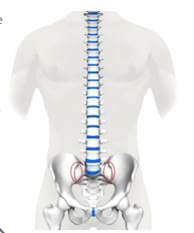Overview
Chiropractic, Physical Therapy and Orthopedic
THE FIRST STEP IN CONSERVATIVE CARE
The study of biomechanics presents a promise: care of the human frame, its supporting musculature, and neural pathways may lead to more balanced health, less pain, and reduced expenditures. Yet, we fail to understand the basic underlying mechanisms that unite the musculoskeletal system. Although we know that the body is an interconnected whole, the big picture is not evident. Sometimes, the simplest things can be overlooked in a vast sea of information that becomes more complicated and less accessible as we gain more knowledge. Sometimes, we go down the wrong path and get stuck in false sureties.
Historically, the sacroiliac joint (SIJ) was considered the main cause of back pain, but it was difficult to diagnose with any specificity. Then, in 1934, the lumbar disc was found to be a cause of back pain and medical research switched to concentrate on the disc and ignored the SIJ. Diagnosis appeared to be clear and surgical treatment obvious. Yet, the past 80 years have not led to a significant resolution of the incidence of pain or disability and failed disc surgery remains a major concern. While the disc is relatively easy to diagnose with objective measures, the SIJ takes more skill.
Over the past several decades, the advances in the science of biomechanics have brought about the re-emergence of the SIJ in both diagnostic and treatment protocols. Since the SIJ acts both as the center of motion as well as the center of shock absorption, it is the core structure of the human body.
 Unfortunately, the lumbar spine is mistakenly thought by many to be the core structure when it is obvious to any biomechanical specialist that, upon observation of pelvic movement, the sacrum and SIJ are the core structures.
Unfortunately, the lumbar spine is mistakenly thought by many to be the core structure when it is obvious to any biomechanical specialist that, upon observation of pelvic movement, the sacrum and SIJ are the core structures.
Interestingly, recent research has found that both a disc herniation and an SIJ lesion may coexist. There is also compelling new research that indicates that the SIJ is the major underlying biomechanical cause of disc herniation. Yet, change is slow in the medical field, which is both a good thing for safety and a bad thing for advancement. We are dealing with human beings in pain, and often within a limited budget. So, it is expected that we exercise a cautious and efficient approach.
Although the lumbar disc still garners the first look for many health care professionals, this should change. Diagnostic and treatment methods for disc herniation are both time consuming and costly. We are all looking for a better, simpler way.
One simple, inexpensive, and often very effective method of both analysis and treatment is the application of the Serola Sacroiliac Belt. If the pain reduces, it is a good indicator that the sacroiliac joint is a major contributor to the patient’s back, hip, or leg pain. Once this first step is accomplished, a referral should be made to a health care professional who treats the musculoskeletal system, with an emphasis on stabilization of the sacroiliac joint. It is as simple and inexpensive as that.
With a background of clinical and literature research in biomechanics since 1989, Dr. Serola has discovered a pattern that integrates the biomechanics of the musculoskeletal system. Although simple to understand, it has escaped detection because it is not where researchers are looking. It is easy to recognize but you have to know where to look before you see. For a more in-depth look into the Serola Theory, which describes the integration of the musculoskeletal system by merging the work of other biomechanical researchers into an efficient functioning model, please refer to the Research section of our website.
Types of Pain Relief
What is Hip Pain
This may seem to have an obvious answer, but quite the contrary is that hip pain can be disguised as many different ailments. The hip and sacroiliac joint are the center holding points for stability in the body. When there is an injury or sprain in the hips or pelvis this can translate to not only pain found directly in the hip but can radiate into the lower back or even as far away as the neck and legs. Hip pain commonly occurs when a ligament or ligaments in the pelvic region have been stressed, strained or even torn. This causes instability in the pelvis and hip, which results in pain, discomfort and limited mobility.
How does the Serola Sacroiliac Belt offer hip pain help?
Hip pain can be extremely distressing and cause issues with quality of life. The Serola Sacroiliac Belt acts as an external ligament holding the joint in normal range of motion. When the joint is placed into the “Normal Range” the muscles that are constantly tightening or turning on are able to relax. With the belt holding the body stable the pain being caused by constant muscle contraction is significantly reduced, if not completely gone. The belt should always be worn during any strenuous activity that involved lifting, bending or twisting. Wearing the Serola Sacroiliac Belt will greatly reduce your chances of being injured or further injuring your body. This will help you avoid having to deal with issues such as hip pain, back pain or sciatic hip pain.
